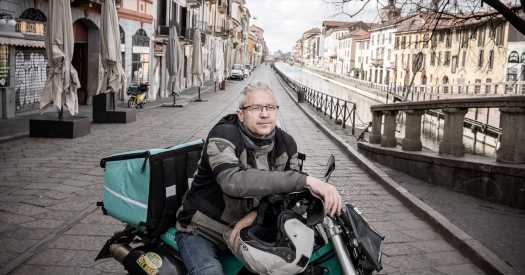Postmates, DoorDash, Uber Eats and Grubhub have also introduced a “no-contact delivery” service so drivers can leave food orders on the front step of a customer’s address without interacting with them.
“Not every job can work from home and certainly that is the reality for our drivers and couriers who need to pay their bills,” Andrew Macdonald, an Uber senior vice president who oversees global operations, said in an interview. “What we’re trying to do is make that experience as safe as possible.”
Uber has 30 people working full time on coronavirus issues, he said. On Sunday, the company introduced a website to help drivers request sick pay. Drivers, who would need documentation from a doctor or public health authority, could request assistance for 30 days after they became sick or were ordered to isolate, Uber said.
Uber and Lyft have since also suspended their carpool services and Uber has warned riders to only travel if necessary.
“We are working hard to support those who drive with Lyft and are coordinating with government officials on additional solutions,” said Alexandra LaManna, a Lyft spokeswoman.
Gig workers in areas with some of the biggest clusters of coronavirus cases have been the most hard hit. In Milan, Italy, Giovanni Marra, 57, has continued to deliver burgers, sushi and other meals for one of the food-delivery apps that have been allowed to keep operating in Italy, Just Eat.
Though Mr. Marra, a former butcher, said he was scared of contracting the virus that has infected more than 31,000 people in Italy, he said he made the devil’s bargain that the health risk was less than the financial peril of not working.
“This is my only source of income. I have rent and bills to pay at the end of the month,” he said in a phone interview. “I could be infected by the person who has prepared the food, by the person who picks it up, by the other riders who wait in groups outside the restaurants.”
Such risks became evident on March 8, when Mayor Bill de Blasio of New York said that a 33-year-old Uber driver from Queens had been hospitalized with the virus. The man, who drove passengers in Long Island, was in stable condition, officials said. Uber said the driver would receive sick pay.
Just Eat, a British company, said in a statement that it was following the advice of government and health authorities and had introduced “contactless delivery.”
Feres Dabouze, an Uber driver in Amsterdam, said that since tourism had dropped sharply because of the virus, he was not making enough to cover his car expenses. The Netherlands has more than 1,700 confirmed coronavirus cases, including more than 40 deaths.
“Should I pay rent or should I pay the insurance for my car? I can’t pay one,” he said.
Back in San Francisco, Mr. Maldonado said he too was worried about keeping up with his expenses. He had started driving for Lyft two years ago, after his family bakery in the city’s Mission neighborhood shut down.
He said the coronavirus began hurting business over the past week, as more flights were canceled and commuter passengers disappeared after their employers encouraged them to work from home.
At the waiting lot outside San Francisco International Airport that day, more than 200 cars were in Lyft’s automated queue, which dispatches drivers to the airport in the order in which they arrive. As he was at the back of that line, Mr. Maldonado got out of his vehicle to chat with other drivers.
“It’s like September 11th,” said Wilton Nery, another ride-hailing driver. He said he had emigrated to the United States 34 years ago, first driving a cab, then an Uber, and now a Lyft.
“What are you going to do?” Mr. Nery said with a shrug. “It’s tough.”
Leandro Lemos, another Lyft driver, leaned against a chain-link fence, fiddling with an unlit Marlboro and fretting about his declining earnings.
“They canceled all the conventions, the Warriors games. All the big tech companies are telling their employees to stay home,” Mr. Lemos said. His earnings have dropped to $150 a day from around $400 previously, he said, and he is worried about paying his bills — as well as the lack of sanitizing supplies.
Mr. Maldonado told Mr. Lemos he had some extra masks and invited him to come to his car, where he had them tucked away.
Some drivers slept in their cars while they waited to move up the queue. Others swabbed down their car door handles with disinfectant wipes or talked about what other work they might find if the lack of rides continued. Mr. Lemos said he might get a commercial license so he could drive trucks.
After an hour and a half, Mr. Maldonado was finally at the front of the queue. He picked up a passenger and drove her 14 miles north, into San Francisco. But an error occurred in the Lyft app and didn’t record the full length of the ride, leaving him with a payment of $3.75.
After 30 minutes of trying to reach Lyft’s customer service, he was able to explain the situation to the company. The fare increased to $14.
Over the afternoon, Mr. Maldonado developed a dry cough. He worried he could have the virus, but did not want to stop driving. “I have mortgage to pay,” he texted later. “I won’t make it.”
On Thursday around 12:30 p.m., Mr. Maldonado was back at the airport lot, waiting. His last ride had been hours ago, at 9:30 a.m.
Kate Conger and Mike Isaac reported from San Francisco and Adam Satariano from London. Emma Bubola contributed reporting from Verona, Italy.
Source: Read Full Article
